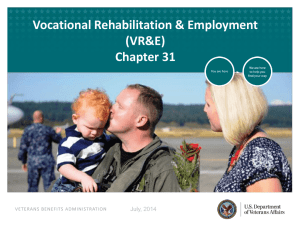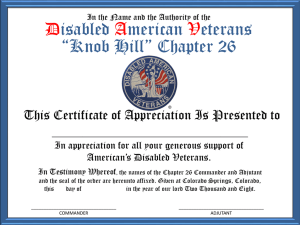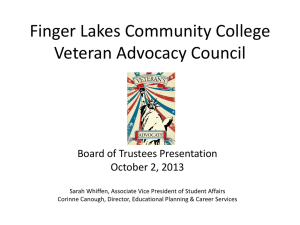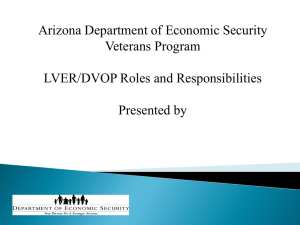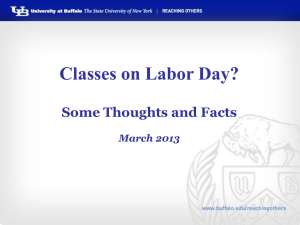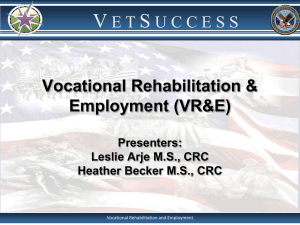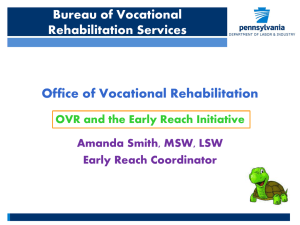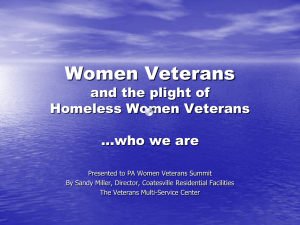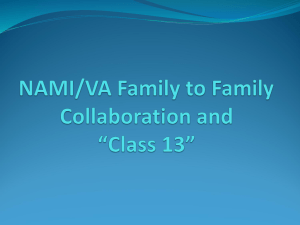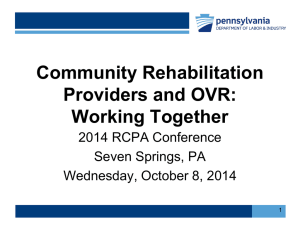CSAVR 2013 Fall Veterans Presentation
advertisement
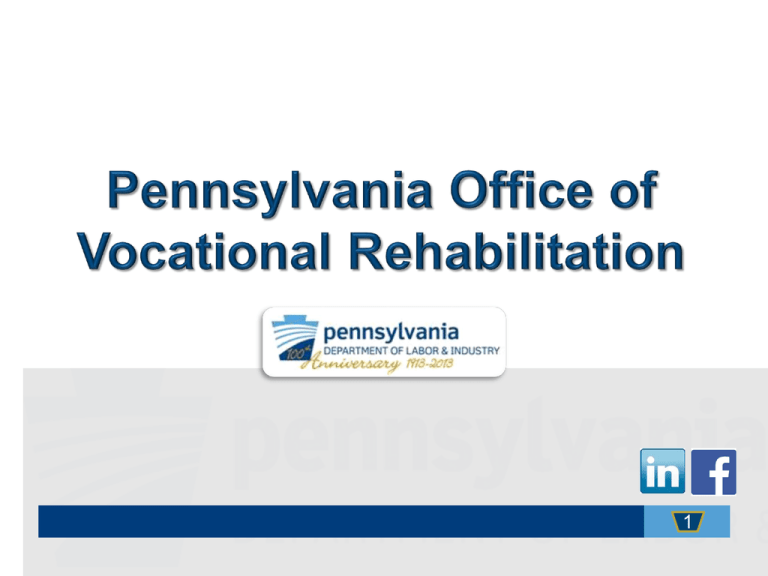
1 15 Offices across the state of PA 1200 Total Staff 80,000 customers served yearly OVR Central Office in Harrisburg Hiram G. Andrews Center in Johnstown OVR Directory Link toOffice OVR’s Website 2 PA has 937,000 Veterans 466,000 Veterans are in the PA labor force The PA Unemployment Rate among veterans is 6.7% compared to a state average of 7.5% Linkto to OVR’s RSA’s Website Link Website 3 PA has 159,000 Veterans with disabilities 85,300 Veterans with disabilities are in the PA Labor Force Veterans are returning from conflicts with more significant disabilities Existing veterans are experiencing new disabilities Linkto to OVR’s RSA’s Website Link Website 4 In 2008, The Office of Vocational Rehabilitation (OVR) decided to affirm it's commitment to veterans services. Created a central Veteran’s services Coordinator Started researching collaborative models of agreement Link to to OVR’s Website Link Website 5 Starting meeting with VA VR&E in 2008 VA VR&E top officials were located in both ends of the state Letter of Understanding finalized in 2009 Promoted a shared vision to serving veterans with disabilities Link to to OVR’s Website Link Website 6 • The American Recovery and Reinvestment Act (ARRA) provided a unique opportunity in PA to enhance services to individuals with disabilities. • OVR dedicated 1 million dollars of ARRA funds to build a veterans program • Goals of the program included: dedicated counselors, training Link to to OVR’s Website Link Website 7 Started a pilot program with 3 dedicated counselors from the Eastern, Western and Central Offices These 3 counselors established working relationships with other veterans programs, including VA VR&E, CareerLink Vet Reps, Veteran’s Service Organizations and the VA. Counselors were imbedded into these organizations Link to to OVR’s Website Link Website 8 Every District Office Dedicated Veterans Counselor Link to to OVR’s Website Link Website 9 • • • • Have veterans serving veterans, if possible Military culture is hard to understand Specialized training is necessary Services should support the veteran and his/her family Link to to OVR’s Website Link Website 10 No Single System Territoriality Reaching OIF/OEF Veterans Link to to OVR’s Website Link Website 11 The Military Culture PTSD, Dealing with Loss Cognitive Rehab for Mild TBI Substance Abuse DVBIC System Vet Centers Suicide Prevention Link to to OVR’s Website Link Website 12 Developed a year long training series for staff based on the IRI “When Johnny and Jeannie came Marching Home… “ Each Chapter was turned into a video conference training CRC credits were provided Link to to OVR’s Website Link Website 13 OVR is making a difference in the lives of veterans with disabilities in PA! Link to to OVR’s Website Link Website 14 Questions? Presented By: Denise Verchimak Director Department of Labor & Industry Bureau of Vocational Rehabilitation dverchimak@pa.gov a Question LinkEmail to OVR’s Website 15 Veterans Services Sean Burlile, Ph.D. Chair, Idaho State Rehabilitation Council Veterans Services This year marks the 40th anniversary of two significant events for Veterans and people with disabilities… • Operation Homecoming: February 12, 1973, American POWs were released from captivity in Hanoi, bringing national attention to the needs of Veterans returning from war. • Rehabilitation Act signed by President Nixon, September 26, 1973. Services to Veterans and others with disabilities have improved in the last 40 years, but we can do much, much more… POW Returning from Vietnam VA VR&E The U.S. Department of Veterans Affairs (VA) Vocational Rehabilitation and Employment (VR&E) program provides VR services for eligible Veterans with service-connected disabilities. Entitlement Criteria: To be found entitled to VR&E services a Veteran must have at least a 20% service-connected disability AND an employment handicap OR a 10% service-connected disability AND a serious employment handicap. A service-connected disability CAN include any chronic medical condition that was diagnosed while a Veteran was on active duty OR a chronic medical condition that is a result of military service OR a pre-existing condition that was aggravated by military service. The goal of VR&E is to provide eligible Veterans with all the services necessary to obtain and maintain suitable employment, or the ability to live independently. 5-Track to Employment • Reemployment • Rapid Access to Employment • Self-Employment • Employment Through Long-term Services • Independent Living Comprehensive Services While the goal of VR&E is employment, most rehabilitation plans include some type of education or training. VA pays for, or provides ALL services necessary to enable the Veteran to achieve their vocational goal. Services MAY include: Testing Evaluations Disability Advocacy Medical Services Dental Services Education/Training (tuition, fees, supplies, monthly stipend) Job Placement Assistance The Underserved Veteran While services to Veterans have improved tremendously in the past 40 years, there are a significant number of underserved Veterans. • VR&E services are for Veterans with service-connected disabilities. • Most Veterans with disabilities do not become disabled while in the military, so their disabilities are not service-connected. As the Veteran population continues to age, more Veterans will suffer from nonservice-connected disabilities and need services. State VR and VA can collaborate to provide these services. • The Rehab Act has little mention of services to Veterans. • Many State VR Counselors assume that because a person with a disability is a Veteran, that the VA will provide all services. • The lack of understanding and collaboration between the VA and State VR agencies can lead to Veterans being underserved. Learning from the Pennsylvania Model • While we know a high number of Veterans are returning from conflicts with disabilities, it is important to understand that existing Veterans are experiencing new nonservice-connected disabilities, which could make them ineligible for VR&E services. • Creation of a Central Veterans Services Coordinator. While it may not be feasible for some states to create a full-time Veterans Services Coordinator, State VR agencies could have a staff member designated as the point-ofcontact on matters related to Veterans affairs. This works great in the State of Idaho. • Designate a supervisor in each office to be a Veterans Services Coordinator. • Develop memorandums of understanding (MOUs) with VR&E. • Share training resources and training opportunities with VR&E. Other Areas to Collaborate As workloads increase and budgets shrink we need to find innovative ways to improve services to people (including Veterans) with disabilities. • Get a VR&E Counselor on your SRC! • The VA website, va.gov, provides free Careerscope testing. Encouraging State VR clients to utilize this testing, which could provide cost savings for state agencies. • Post VA literature at all VR Regional Offices. Many Veterans do not realize they are eligible for VA benefits, including medical care. • Many VR clients who served honorably in the military are eligible for VA healthcare, regardless of service-connected disability. VA Medical Centers provide many assistive devices, to include: hearing aids, prosthetics, smart pens, and blind rehabilitation assistive devices. • Veterans in rural locations needs support. Often times there is not a VR&E counselor in a rural location. This is a good opportunity to co-manage a case. If a state VR counselor could conduct office visits, perhaps the VA could provide financial support. Questions Sean Burlile Chair, Idaho State Rehabilitation Council 208-426-3754 sean.burlile@va.gov
